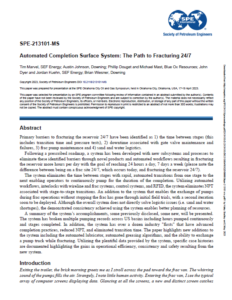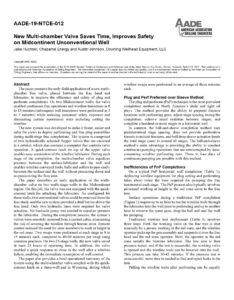AADE National Tech Conference and Exhibition | AADE-25-NTCE-033 | April 2025
Unlocking the Myths: Continuous Pumping is Not Continuous Fracturing
Tim Marvel, Jose Padilla
ABSTRACT
Since the introduction of the continuous pumping concept in 2020, automation and operational capabilities have steadily improved with refined algorithmic control cycles and minimized inefficiencies. These advances have enabled uninterrupted 24/7 hydraulic fracturing operations, establishing a new standard in completions efficiency. While the term “continuous pumping” has gained widespread adoption within the industry, its original intent has become distorted, leading to misinterpretations that blur the distinction between actual fracturing time and non-productive pumping time (NPP).
Currently, many operators utilize non-standard pumping efficiency metrics that obscure and inhibit potential optimization opportunities. These metrics typically focus on total pumping time, which includes non-fracturing periods such as acid displacement, manual valve actuations, approval processes or slow response to action, thus masking the true measure of fracturing effectiveness. This misalignment results in an inflated view of pumping performance, while critical efficiency improvements—particularly during active fracturing—are overlooked.
This paper will redefine “continuous pumping” and introduce key concepts such as continuous fracturing (CF), non-productive pumping (NPP), and invisible lost time (ILT). CF, unlike the broader pumping definition, focuses on maximizing productive time during fracturing intervals, thereby capturing the full potential of 24/7 fracturing operations. ILT, which represents the hidden time losses during pumping operations, further underscores the inefficiencies masked by current pumping metrics. Through detailed case histories and analytics, this paper will demonstrate the impact of continuous fracturing, showcasing substantial performance gains by shifting to fracturing-based efficiency metrics.
To Request Paper and Presentation Please Email sales@downingusa.com
SPE Oklahoma City Oil and Gas Symposium | SPE-213101-MS | April 2023
Automated Completion Surface System: The Path to Fracturing 24/7
Tim Marvel, Austin Johnson, Phillip Douget, Michael Mast, John Dyer, Jordan Kuehn, Brian Wiesner
ABSTRACT
Primary barriers to fracturing the reservoir 24/7 have been identified as 1) the time between stages (this includes transition time and pressure tests), 2) downtime associated with gate valve maintenance and failures, 3) frac pump maintenance and 4) sand and water logistics.
Following a prescribed roadmap, a system has been developed with new subsystems and processes to eliminate these identified barriers through novel products and automated workflows resulting in fracturing the reservoir more hours per day with the goal of reaching 24 hours a day, 7 days a week (please note the difference between being on a frac site 24/7, which occurs today, and fracturing the reservoir 24/7).
The system eliminates the time between stages with rapid, automated transitions from one stage to the next enabling operators to continuously pump for the duration of the completion. Utilizing automated workflows, interlocks with wireline and frac systems, control systems, and RFID, the system eliminates NPT associated with stage-to-stage transitions. An addition to the system that enables the exchange of pumps during frac operations without stopping the frac has gone through initial field trials, with a second iteration soon to be deployed. Although the overall system does not directly solve logistic issues (i.e. sand and water shortages), the demonstrated consistency achieved using the system enables better planning of resources.
A summary of the system’s accomplishments, some previously disclosed, some new, will be presented. The system has broken multiple pumping records across US basins including hours pumped continuously and stages completed. In addition, the system has over a dozen industry “firsts” that have advanced completion practices, reduced NPT, and eliminated transition time. The paper highlights new additions to the system including the automated lubricator, automated greasing algorithms, and the ability to exchange a pump truck while fracturing. Utilizing the plentiful data provided by the system, specific case histories are documented highlighting the gains in operational efficiency, consistency and safety resulting from the new system.

AADE Technical Conference | AADE-19-NTCE-012 | April 2019
NEW MULTI-CHAMBER VALVE SAVES TIME, IMPROVES SAFETY ON MIDCONTINENT UNCONVENTIONAL WELL
Jake Huchton, Chaparral Energy and Austin Johnson, Downing Wellhead Equipment, LLC
ABSTRACT
The paper presents the early field application of a new multi-chamber frac valve, placed between the frac head and lubricator, to improve the efficiency and safety of plug and perforate completions. On two Midcontinent wells, the valve enabled continuous frac operations and wireline transitions in 8 to 15 minutes (subsequent well transitions were performed in 3 to 5 minutes) while reducing personnel safety exposure and eliminating certain operational risks including cutting the wireline.
The new system was developed to make it faster, easier and safer for crews to deploy perforating and frac plug assemblies during multi-stage frac completions. The system is comprised of two hydraulically actuated flapper valves that are enclosed in a cabinet, which also contains a computer that controls valve operation. A quick-connect latch on top of the upper valve enables easy connection of the wireline lubricator. During each stage of the completion, the multi-chamber valve equalizes pressure between the surface/lubricator and the well and enables wireline conveyed tools, balls and collets to pass easily between the surface and the well without pressuring down and re-pressurizing the flow iron.
The paper describes an early application of the multi-chamber valve on two multi-stage wells in the Midcontinent region. On this job, the valve was not equipped with the quick-connect latch for attaching the lubricator. As configured for these wells, two conventional valves could be removed from the frac stack, and the new system provided a dual barrier above the frac head. Only two hydraulic lines were required for valve actuation. No backside pump was needed to equalize pressure in the lubricator. During the completion process, the system’s valves were remotely operated from a control cabin, eliminating the risk of severing the wireline through human error. Remote control reduced the need for crew members to work at height in the red zone. Two swaps were performed at each stage in 8 to 15 minutes each, compared to 40-60 minutes per swap using common practices. On two 25-stage wells, the new valve saved at least 25 hours of operating time. In addition, the valve enabled a quick response to close in the well after a wireline failure, enabling the immediate resumption of well control.
The paper also provides a brief operational summary of the system using the multi-chamber valve coupled with the quick-connect latch on a three-well pad in Wyoming, during which wireline swaps were performed in an average of three minutes each.



